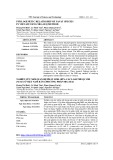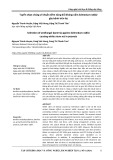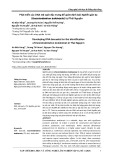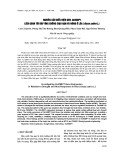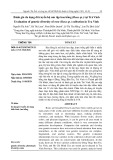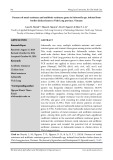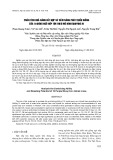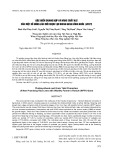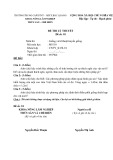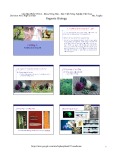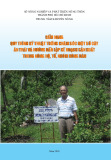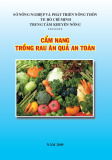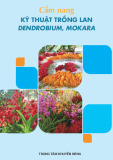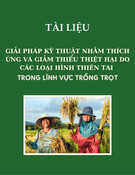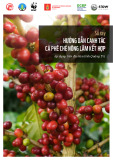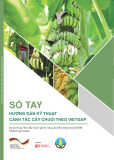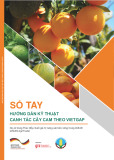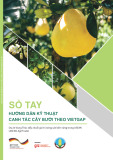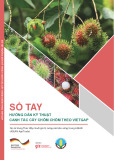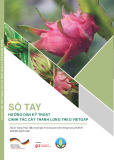
Int.J.Curr.Microbiol.App.Sci (2020) 9(11): 623-628
623
Original Research Article https://doi.org/10.20546/ijcmas.2020.911.076
Confirmation of Hybridity using DNA-based Markers is Essential in
Chickpea (Cicer arietinum L.)
Sanchit Thakur1, Jai Dev Sharma2* and Kamal Dev Sharma3
1Department of Plant Breeding and Genetics, 2Department of Tea Husbandry & Technology,
3Department of Agricultural Biotechnology, CSKHPKV, Palampur, India
*Corresponding author
A B S T R A C T
Introduction
Chickpea (Cicer arietinum L.) (2n=2x=16) is
one of the important pulse crop that was first
grown in Turkey about 7000 BC (Philologos,
2005). It is a self pollinated crop and belongs
to kingdom Plantae, order Fabales, family
Fabacae, genus Cicer and species arietinum.
The crop is grown traditionally in semi-arid
zones of Middle-East, Pakistan and India.
According to Vavilov (1926), there are two
primary centres of diversity of chickpea,
namely, South-West Asia and Mediterranean
while Ethiopia is designated as the secondary
centre. The centre of origin of the crop is
considered to be in South-Eastern Turkey and
Northern Syria where it is believed to be
evolved from its progenitor Cicer reticulatum
(Maesen, 1987). Chickpea is also known as
Bengal gram, Garbanzo bean, Chana and
Shonagalu in different chickpea producing
areas of the world.
India which contributes to about 60% of the
total world’s production, is the largest
producer and consumer of Chickpea
(Varshney et al., 2014). In India, chickpea is
mainly produced in Madhya Pradesh,
Maharashtra, Rajasthan, Uttar Pradesh,
Andhra Pradesh, Karnataka, Chhattisgarh,
Bihar and Jharkhand and these states
contribute more than 95% to the
International Journal of Current Microbiology and Applied Sciences
ISSN: 2319-7706 Volume 9 Number 11 (2020)
Journal homepage: http://www.ijcmas.com
Confirmation of hybridity is essential to exclude selfed plants in plant breeding
programmes. The morphological markers for confirmation of hybridity in chickpea are
unavailable in closely related germplasm and these results in ambiguity in identification of
true hybrids. In present study, cold tolerant parent ICC-16349 (donor) and cold susceptible
parent GPF-2 (recipient) were crossed to generate 80 putative hybrids. The parents were
screened using 51 simple sequence repeat (SSR) markers, of which only one i.e TA 180
exhibited polymorphism. Screening of 80 putative hybrids using TA 180 revealed that
only 34 (42.5%) of the putative hybrids were true hybrids. The study indicated that in
chickpea breeding programmes, hybridity must be confirmed using DNA based markers to
avoid inclusion of selfed plants as hybrids.
K e y w o r d s
Chickpea,
Hybridization, SSR,
True hybrids
Accepted:
07 October 2020
Available Online:
10 November 2020
Article Info

Int.J.Curr.Microbiol.App.Sci (2020) 9(11): 623-628
624
total production. India still imports it from
other nations besides being the largest
producer of chickpea due to low productivity
which is due to the abiotic and biotic stresses
and use of low yielding varieties.
Lack of diagnostic morphological markers for
the confirmation of hybidity owing to
insufficient genetic variability in cultivated
chickpea species along with shortage of
polymorphic markers is a major constraint for
identification of true hybrids in chickpea
(Atalay & Babazogles, 2012) are the major
hindrances to confirm hybridity in this crop.
Consequently, there are chances of
categorizing false hybrids as true hybrids
leading to errors in the breeding programmes
resulting in wastage of resources and time. At
present, no information is available for the
extent of inclusion of false hybrids in
chickpea breeding programmes. For hybridity
confirmation in chickpea, DNA-based
markers may be the markers of choice to
ascertain the hybrid nature. Among vast
categories of DNA markers available for
chickpea, simple sequence repeats (SSRs) are
preferred due to codominant nature, locus
specificity, high reproducibility and ease to
use (Tautz and Renz, 1984). SSRs, also
known as sequence tagged microsatellite site
or microsatellite markers (Beckmann &
Soller, 1990) are widely used in genetic
diversity analysis, population genetics,
marker assisted selection and genetic
mapping. Most of the important legumes in
India including chickpea are accompanied by
lack of genomic resources as limited SSR
markers have been reported so far. SSR
markers being codominant, detect alleles of
both male and female parents and hence, are
ideal for differentiation of true hybrids from
the selfed individuals. The present study was
formulated to estimate the extent of false
positive hybrids in chickpea and to confirm
the hybridity of F1 plants by using SSR
markers.
Materials and Methods
Hybridization was conducted between two
parents having contrasting traits viz., cold
tolerance (ICC-16349) and cold susceptibility
(GPF-2) where ‘ICC-16349’ was selected as a
donor and ‘GPF-2’ as a recipient. The seeds
of hybrids and parents was sown in 10”
diameter pots using a standard potting
mixture (Soil: Sand: FYM: : 1: 1: 1) . At 3-4
leaf stage, a small amount of leaf tissue from
each putative hybrid was harvested. The
leaves were transported immediately in ice to
lab for DNA extraction. The leaves were
crushed in liquid nitrogen and DNA was
isolated by using CTAB method (Murray and
Thompson, 1980).
The DNA of parents was amplified by using a
set of 51 SSR markers developed by Winter et
al., (1999) and Gaur et al., (2011) (Table 1).
Off the 51 SSR primers, only one i.e. TA 180
generated polymorphism between the parents.
For polymerase chain reaction (PCR) assay,
10 μl PCR reaction mixture was prepared
which constituted 6.7 μl sterile double
distilled water, 1 μl 10X Taq buffer, 0.3 μl
DNTPs (2 mM), 1.2 μl DNA (25-50 ng/μl),
0.2 μl DNA polymerase (1U/μl) and 0.3 μl
each forward and reverse primer. PCR profile
with initial denaturation of 5 min at 950C; 35
cycles with denaturation at 940C for 30
seconds, annealing temperature as per melting
temperature of primer used, followed by
extension at 720C for 1 min; and a final
extension at 720C for 8 mins. The
amplification products were stored at 40C and
were resolved by gel electrophoresis in
horizontal agrose system at 100 V for 2 hrs
staining using ethidium bromide (0.5 μg/ml)
in 3 % agarose gel (0.5X TAE Buffer). Gel
documentation system was used to visualize
the amplified products and size of the
amplicon was estimated by using 100 bp
ladder. Genetic polymorphism was estimated

Int.J.Curr.Microbiol.App.Sci (2020) 9(11): 623-628
625
by comparing size of the bands. The F1s that
showed alleles of both the parents were
termed as hybrids usually referred to as true
hybrids in present study to differentiate those
from putative hybrids.
Results and Discussion
Crosses between chickpea genotypes ‘ICC-
16349’ and ‘GPF-2’ generated a total of 80
putative hybrid seeds, out of which 25 were
from reciprocal crosses and 55 were from
direct crosses. Of the 51 primer pairs of SSRs
used to amplify DNA of both the parents,
only one i.e. TA 180 (1.2 % of total SSRs)
showed polymorphism between the parents.
Hence, TA 180 was used for confirmation of
hybridity of putative hybrids (Figure 1). Out
of 80 putative hybrids screened, only 34
amplified both the alleles corresponding to
ICC-16349 and GPF-2 suggesting that those
34 (42.5%) were true hybrids and 57.5%
putative hybrids were false hybrids.
Table.1 Description of SSR markers used in the present study
Sr No.
Primer name
Forward (5’-3’)
Reverse
Tm (0C)
1
TA8
AAAATTTGCACCCACAAAATATG
CTGAAAATTATGGCAGGGAAAC
55.00
2
TA203
ATAAAGGTTTGATCCCCATT
TGTGCATTCAGATACATGCT
55.00
3
TR43
AGGACGAAACTATTCAAGGTAAGTAGA
AATTGAGATGGTATTAAATGGATAACG
55.00
4
TA30
TCATTAAAATTCTATTGTCCTGTCCTT
ATCGTTTTTCTAAACTAAATTGTGCAT
55.00
5
TA113
TCTGCAAAAACTATTACGTTAATACCA
TTGTGTGTAATGGATTGAGTATCTCTT
55.00
6
TA59
ATCTAAAGAGAAATCAAAATTGTCGAA
GCAAATGTGAAGCATGTATAGATAAAG
55.00
7
TA28
TAATTGATCATACTCTCACTATCTGCC
TGGGAATGAATATATTTTTGAAGTAAA
55.00
8
TA2
AAATGGAAGAAGAATAAAAACGAAAC
TTCCATTCTTTATTATCCATATCACTACA
55.00
9
TA146
CTAAGTTTAATATGTTAGTCCTTAAATTAT
ACGAACGCAACATTAATTTTATATT
55.00
10
TA72
GAAAGATTTAAAAGATTTTCCACGTTA
TTAGAAGCATATTGTTGGGATAAGAGT
55.00
11
TA116
AATTCAATGACGAATTTTTATAAGGG
AAAAAGAAAAGGGAAAAGTAGGTTTTA
55.00
12
TA130
TCTTTCTTTGCTTCCAATGT
GTAAATCCCACGAGAAATCAA
55.00
13
TR20
ACCTGCTTGTTTAGCACAAT
CCGCATAGCAATTTATCTTC
55.50
14
NCPGR209
ATTGTTTGTTGGAGTGATGG
CACGGTTTCATTGTCTTGTT
55.00
15
TA22
TCTCCAACCCTTTAGATTGA
TCGTGTTTACTGAATGTGGA
55.00
16
TA80
CGAATTTTTACATCCGTAATG
AATCAATCCATTTTGCATTC
55.00
17
TA176
ATTTGGCTTAAACCCTCTTC
TTTATGCTTCCTCTTCTTCG
55.00
18
TR44
TTAATATTCAAAAACTCTCTTGTGCAAT
TTTACAACAGCGCTTGTATTTAGTAAG
55.00
19
TR35
ACTTTGGTTTAACATTTTCGGTAGTTA
AGTATCAACGTCATGTGTAACTCGTAT
55.00
20
TR1
CGTATGATTTTGCCGTCTAT
ACCTCAAGTTCTCCGAAAGT
55.00
21
TA180*
CATCGTGAATATTGAAGGGT
CGGTAAATAAGTTTCCCTCC
55.00
22
TA14
TGACTTGCTATTTAGGGAACA
TGGCTAAAGACAATTAAAGTT
55.00
23
TA78
CGGTAAATAAGTTTCCCTCC
CATCGTGAATATTGAAGGGT
55.00
24
TA64
ATATATCGTAACTCATTAATCATCCGC
AAATTGTTGTCATCAAATGGAAAATA
55.00
25
NCPGR264
TGGGAATCTTGTTGGTTCTT
TGAAAGGAGATGGAAAAAGC
57.10
26
TS43
AAGTTTGGTCATAACACACATTCAATA
TAAATTCACAAACTCAATTTATTGGC
55.00
27
TA5
ATCATTTCAATTTCCTCAACTATGAAT
TCGTTAACACGTAATTTCAAGTAAAGAT
55.00
28
NCPGR263
CAAGGATGAATGTGTGTGTG
CATAGTATCCTCGGTTTCCC
55.50
29
NCPGR136
GGACTGAGTGAGTTCGTCTT
GTATCCTCGGTTTCCCTATC
54.00
30
NCPGR117
GAACTTCTTCAATCTCACGG
CTAGCACGATGAAAGGATTC
54.50
31
NCPGR247
CAATGATTGGTTCTCTCCTC
GGTTTGACTAAAATATGGCG
54.50
32
NCPGR281
GCAATGATTGGTTCTCTCCT
GTGGAATTCTTTAGGGTTTGAC
56.50
33
NCPGR231
AACCTCCGTCCACACATTTC
GGTCGAAGCCATTGTTTTGT
59.40
34
NCPGR224
TGGAATTAGTTGATGTGACAA
ATTTCCCGTGTCTTTGAGAT
59.20

Int.J.Curr.Microbiol.App.Sci (2020) 9(11): 623-628
626
35
NCPGR214
ATTTCCCGTGTCTTTGAGAT
GGAATTAGTTGATGTGACAATG
54.50
36
NCPGR127
CATAATGCAAGGGCAATTAG
CTCTTATCTTCATGTTGCCG
55.50
37
NCPGR111
AATAACTCCATTTGGCTTGA
GCGGTAATTACACAATACAGG
54.50
38
NCPGR142
TAACTCCATTTGGCTTGAGA
TAACCTTATATGGTAGGCGG
54.50
39
NCPGR252
TTGCCCTGAGGAATACATTA
GGTTGTTGAAGGCATAACTG
54.30
40
NCPGR255
TCAGTGGTATTGAGACATCG
CCATCTTCAAAAGTGAACCT
54.00
41
TA25
AGTTTAATTGGCTGGTTCTAAGATAAC
AGGATGATCTTTAATAAATCAGAATGA
55.00
42
TA42
ATATCGAAATAAATAACAACAGGATGG
TAGTTGATACTTGGATGATAACCAAAA
55.00
43
GA 11
GTTGAGCAACAAAGCCACAA
TTCTTGTCTGGTTGTGTGAGC
55.00
44
TS83
AAAAATCAGAGCCAACCAAAAA
AAGTAGGAGGCTAAATTATGGAAAAGT
55.00
45
TA96
TGTTTTGGAGAAGAGTGATTC
TGTGCATGCAAATTCTTACT
55.00
46
TA37
ACTTACATGAATTATCTTTCTTGGTCC
CGTATTCAAATAATCTTTCATCAGTCA
55.00
47
TA27
GATAAAATCATTATTGGGTGTCCTTT
TTCAAATAATCTTTCATCAGTCAAATG
55.00
48
NCPGR254
GCCTTTTTCAATTTCTCTCA
CCCAAAGAAGACAAAACAAC
54.50
49
NCPGR261
GATTGTGTGGCAAAATCCAT
ACTCTCAGGTTGCTGTTCTGA
58.90
50
NCPGR146
AACGTGAAATTCCACCACTA
GAGTCGATTTCGTGTTGATT
55.40
51
TA96
TGTTTTGGAGAAGAGTGATTC
TGTGCATGCAAATTCTTACT
55.00
*polymorphic primer
Fig.1 Amplification pattern of parents (ICC-16349 and GPF-2) and putative hybrids as revealed
by SSR marker TA 180. Names of parents and hybrids are given at the termini of lanes. M=100
bp DNA ladder, * = true hybrids
The study suggested that in chickpea breeding
programmes, hybridity must be confirmed
using DNA based markers to avoid inclusion
of selfed plants in breeding programmes. The
study further indicated that chickpea breeders
usually include significant number (>50%) of
selfed plants as hybrids in breeding
programmes, thereby jeopardizing the
objective of chickpea improvement. Similar
studies regarding hybridity confirmation were
conducted by various workers. SSR markers
have already been used for confirmation of
hybridity in chickpea (Smitha and Katageri,
2019). They identified 13 markers which were
polymorphic for both the parents i.e. Super
Annigeri-1 × BS 100B and Super Annigeri-1
× BS 72C2. However, only one marker
ICCM0299 was able to detect the presence of
both the parental alleles in F1s and thus, was
used for confirmation of hybridity. Morais et
al., (2016) genotyped common bean with 24
microsatellite markers. Out of 342 F1s
obtained from 21 different parental crosses,
325 (82.91%) were confirmed as true hybrids.
Johnson et al., (2019) conducted hybrid
testing and studied heterosis in relation to
genetic divergence in chickpea under rice
based cropping system. A total of 25 SSR
markers with known sequences were used out
of which only SSR21 and SSR22 were

Int.J.Curr.Microbiol.App.Sci (2020) 9(11): 623-628
627
polymorphic between the parents. Reena and
Jaiwal (2014) confirmed intra-specific and
inter-specific F1 hybrids for salt tolerance in
mungbean using trait specific SSRs. Sixteen
different intra-specific and inter-specific
hybrid populations obtained by three type of
crosses among salt susceptible and salt
tolerant lines were tested for hybridity by
using 15 gene specific SSRs. Only two
primers i.e. SSR3435 & SSR4041 produced
polymorphism between the parents. The SSR
markers in addition to hybridity confirmation
have also been used for testing genetic purity
in maize (Wang et al., 2002) and rice
(Nandakumar et al., 2004).
Identification and characterization of hybrid
cultivars is important for varietal
improvement, seed production and release.
For successful crop production, genetic
production of hybrid seed must be
maintained. Use of DNA markers offer
distinct advantages over biochemical and
morphological markers. Morphological
markers are highly influenced by
environmental factors and are time and labour
consuming. Also, biochemical markers e.g.
protein and isozyme markers are least
affected by environment but they fail to
differentiate closely related genotypes due to
limited polymorphism (Luchhese et al.,
1999). DNA markers overcome most
drawbacks of biochemical and morphological
markers and are useful for identification of
hybrids.
The present study revealed that SSRs were
robust and reliable markers for confirmation
of hybridity in chickpea. The study also
revealed that chickpea crossing might
generate high proportion of selfed plants that
may be designated falsely as hybrids. The
study further demonstrated that putative
hybrids must be confirmed by the use of SSR
markers to identify true hybrids and to omit
any errors of inclusion of false hybrids in
breeding programme.
References
Atalay, E., and Babaoglu, M. 2012.
Determination of genetic relationship
in Turkish Chickpea (Cicer arietinum
L.) genotypes using SSR molecular
markers and capillary electrophoresis.
The J. of Animal & Plant Sci, 22 (2):
369-375.
Beckmann, J.S., and Soller, M.W. 1990.
Toward a unified approach to genetic
mapping of eukaryotes based on
Sequence Tagged Microsatellite Sites.
Nat. Biotechnol., 8: 930-932.
Gaur, R., Sethy, N.K., Choudhary, S.,
Shokeen, B., Gupta, V. and Bhatia, S.
2011. Advancing the STMS genomic
resources for defining new locations on
the intraspecific genetic linkage map of
chickpea (Cicer arietinum L.). BMC
Genomics, 12: 117.
Johnson, P.L., Sharma, R.N., Nanda, H.C.
2019. Hybridity testing and heterosis in
relation to genetic divergence in
chickpea (Cicer arietinum L.) under
rice based cropping system. Indian
Journal of Genetics and Plant Breeding
(The)., 79 (3): 622-5.
Luchhese, C., Dinelli, G., Miggiano, A. and
Lovato, A. 1999. Identification of
pepper (Capsicum spp.) cultivars by
field and electrophoresis tests. Seed
Science & Technology, 27: 37-47.
Maesen, V.D.L.J.G. 1987. Origin, history and
taxonomy of chickpea. In: Eds MC
Saxena and KB Singh. The Chickpea,
C.A.B. International, Wallingford, UK.
pp. 11–34.
Morais, S.R., Vieira, A.F., Almeida, L.C.,
Rodrigues, L.A., Melo, P.G., Faria,
L.C., Melo, L.C., Pereira, H.S. and
Souza, T.L. 2016. Application of
microsatellite markers to confirm
controlled crosses and assess genetic
identity in common bean. Crop
Breeding and Applied Biotechnology.,
16 (3): 234-9.

